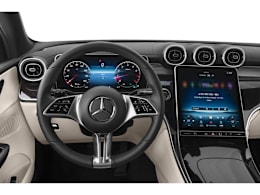The redesigned GLC, now in its second generation, remains a competitive entry in the compact luxury SUV class, with good fuel economy, a quiet and well-made cabin, and comfortable seats. It checks most of the boxes when it comes to the features expected in a luxury model. But, as is the case with so many newer Mercedes-Benz vehicles, the driving experience is marred by hard-to-master touch-sensitive controls. Even once drivers get used to them, making adjustments to the radio, climate, or cruise control still requires more attention than simply pressing a button or turning a knob.
We also aren’t enamored with the GLC’s overly-firm ride quality, or its mushy brake-pedal feel. Even with those missteps, though, it still earned a decent road-test score—there is a lot more good here than bad. But, Mercedes’ below-par brand reliability brings the GLC’s Overall Score down far below most of its rivals.
After an initial—and slightly annoying—delay of power taking off from a stop, the GLC300’s standard 2.0-liter 255-horsepower, turbocharged four-cylinder engine packs a strong, smooth punch, barring the occasional bumpy downshift from the nine-speed automatic transmission. Mash the accelerator pedal and the “4Matic” version we tested (that’s Mercedes’ term for the GLC’s optional all-wheel-drive system; rear-wheel drive comes standard) can zip from 0 to 60 mph in 6.6 seconds, which is quite quick for the class. The engine emits a mostly satisfying hum when revved. The GLC’s standard 48-volt mild-hybrid setup aids the SUV’s 26 mpg overall, which is excellent for the segment.
Handling is responsive, with enough feedback through the steering that the driver feels connected to the road. It doesn’t possess the precision of a BMW X3, for example, but you can tackle corners with confidence thanks to its taut, tied-down suspension. Unfortunately, the GLC struggled through our collision-avoidance maneuver because of an aggressive electronic stability control (ESC) system that clamped down too hard on the brakes.
We were surprised by the GLC’s ride quality, or lack thereof. There’s more than just an underlying firmness going on here; some bumps come through in an overly pronounced way, which is uncharacteristic for a Mercedes—although, the latest C-Class sedan we tested suffered similarly. Still, the SUV remains steady and composed at speed, and instills a sense of solidity and stability.
Also like the C-Class, the GLC suffers from mushy-feeling brakes that require you to press the pedal further down toward the floor than is typical, although it stopped competitively short in our panic-braking test on our dry surface.
The cabin is very quiet, with barely a trace of wind or road noise. And Mercedes didn’t spare on luxury and interior quality; matte wood, brushed aluminum, smooth acting turbine-shaped air vents, and piano-black surfaces all contribute to a luxurious and high-tech ambience. The front seats are comfortable and supportive even for the long haul, with four-way lumbar adjustments for both driver and passenger. As with other Mercedes models, the steering wheel blocks large chunks of information toward the top of the driver’s instrument screen, which is annoying. The rear seat offers generous headroom and lots of foot space, but the seatback forces passengers to sit at attention and it doesn’t recline.
The latest “MBUX” (Mercedes-Benz User Experience) infotainment system gives you tech overload. It has a wide range of abilities, but it’s frustrating that just about every media and climate function runs through the large center touchscreen. Plus, the finger-sliding, capacitive-touch controls on the steering wheel—to adjust the audio volume or cruise-control speed—require too much dexterity while driving. We also found the new capacitive-touch seat controls awkward to use. Overall, the complicated controls put a big damper on the GLC’s driving experience.
Automatic emergency braking with pedestrian and cyclist detection, automatic emergency braking that operates at highway speeds, blind spot warning, rear cross traffic warning, reverse automatic emergency braking, and automatic high beams come standard. Lane centering assistance, lane departure warning, lane keeping assistance, and adaptive cruise control are all optional, instead of standard. One of the optional driver assistance features, “Auto Lane Change Assist,” gives the GLC the ability to change lanes on its own during highway driving.


























